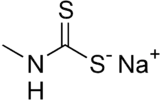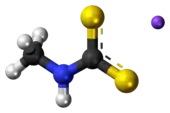Metam sodium
Metam sodium is an organosulfur compound with the formula CH3NHCS2Na. The compound is a sodium salt of a dithiocarbamate. The compound exists as a colorless dihydrate, but most commonly it is encountered as an aqueous solution.[2] It is used as a soil fumigant, pesticide, herbicide, and fungicide. It is one of the most widely used pesticides in the United States, with approximately 60 million pounds used in 2001.[3]
 | |
 | |
| Names | |
|---|---|
| Preferred IUPAC name
Sodium methylcarbamodithioate | |
| Other names
Metham sodium Carbathion Carbathione Carbothion Metamsodium Metam-sodium | |
| Identifiers | |
3D model (JSmol) |
|
| ChemSpider | |
| ECHA InfoCard | 100.004.812 |
PubChem CID |
|
| UNII | |
CompTox Dashboard (EPA) |
|
| |
| |
| Properties | |
| C2H4NNaS2 | |
| Molar mass | 129.18 g/mol |
Except where otherwise noted, data are given for materials in their standard state (at 25 °C [77 °F], 100 kPa).
Infobox references | |
Preparation and properties
Metam sodium is prepared by combining methylamine, carbon disulfide, and sodium hydroxide:[2]
- CH3NH2 + CS2 + NaOH → CH3NHCS2Na + H2O
It also arises from the reaction of methyl isothiocyanate and sodium thiolate.[1]
Upon exposure to the environment, metam sodium decomposes to methyl isothiocyanate.[4]
Safety and environmental considerations
Metam sodium is nonpersistent in the environment since it is prone to hydrolysis. The degradation products, carbon disulfide and methyl amine are however toxic. In 1991 a tank car with 19,000 gallons of metam sodium spilled into Sacramento River above Lake Shasta. This killed all fish in a 41-mile stretch of the river. By 20 years later the rainbow trout population had recovered.[5]
See also
- Zineb - A related dithiocarbamate salt which is also used as a fungicide
References
- Merck Index, 11th Edition, 5860.
- Hartwig, Jürgen; Sommer, Herbert; Müller, Franz (2008). "Nematicides". Ullmann's Encyclopedia of Industrial Chemistry. doi:10.1002/14356007.a17_125.pub2. ISBN 978-3527306732.
- 2000-2001 Pesticide Market Estimates Archived 2009-02-07 at the Wayback Machine, U.S. Environmental Protection Agency
- Review of Metam Sodium, Dazomet, Methylisothiocyanate (MITC) Archived 2009-07-13 at the Wayback Machine, Australian Pesticides and Veterinary Medicines Authority, June 1997
- "Largest chemical spill in California history". dtsc.ca.gov. Retrieved 2017-12-11.
External links
- Metam sodium in the Pesticide Properties DataBase (PPDB)